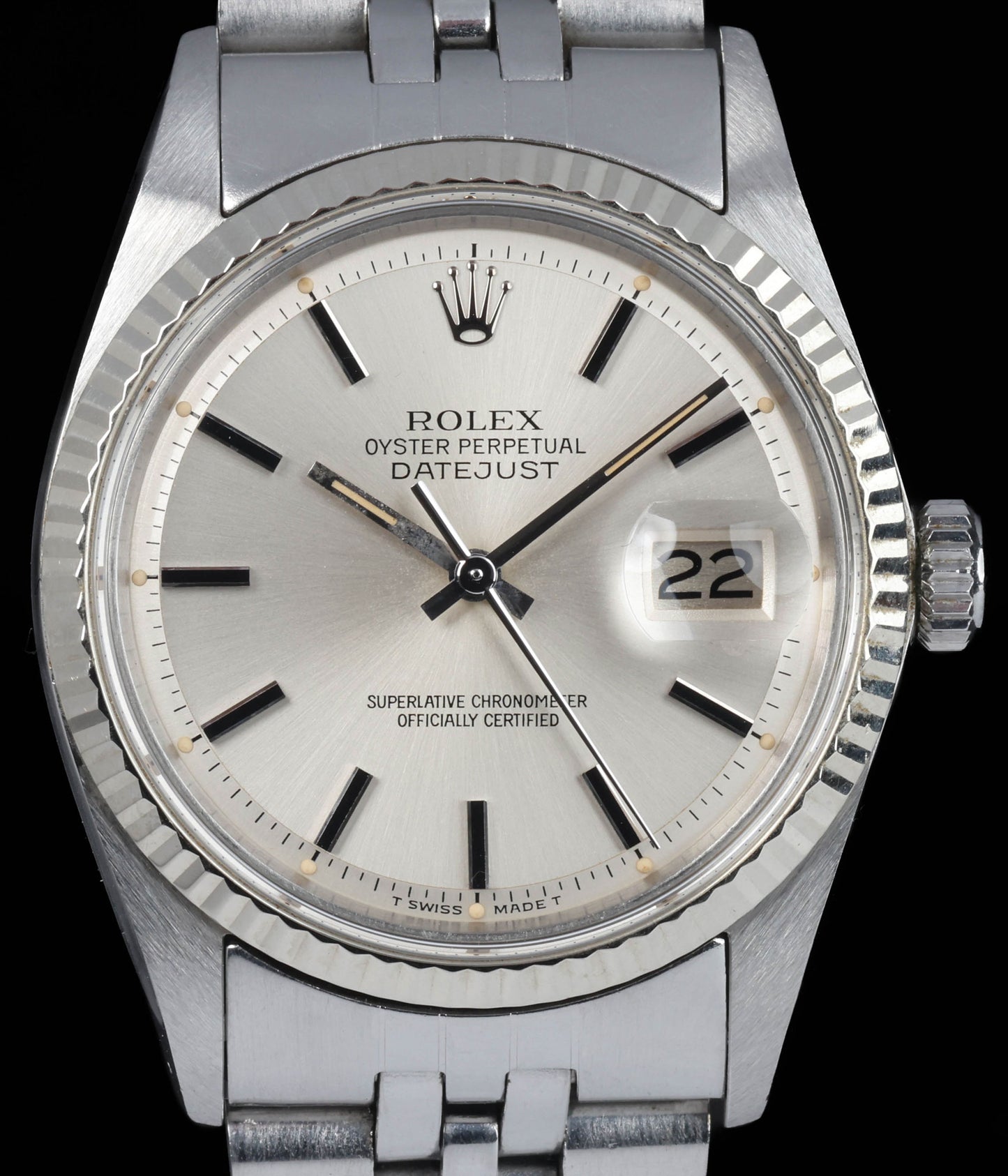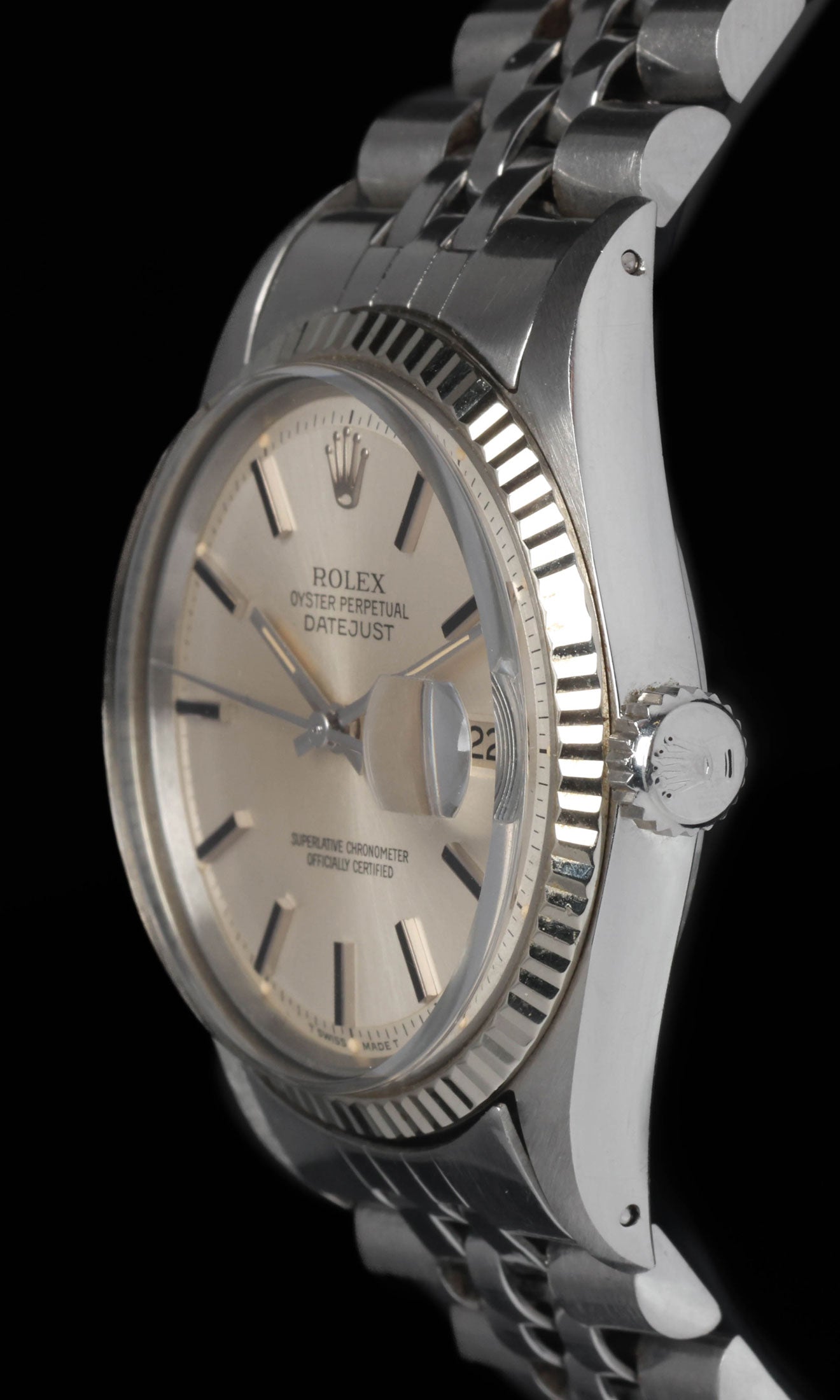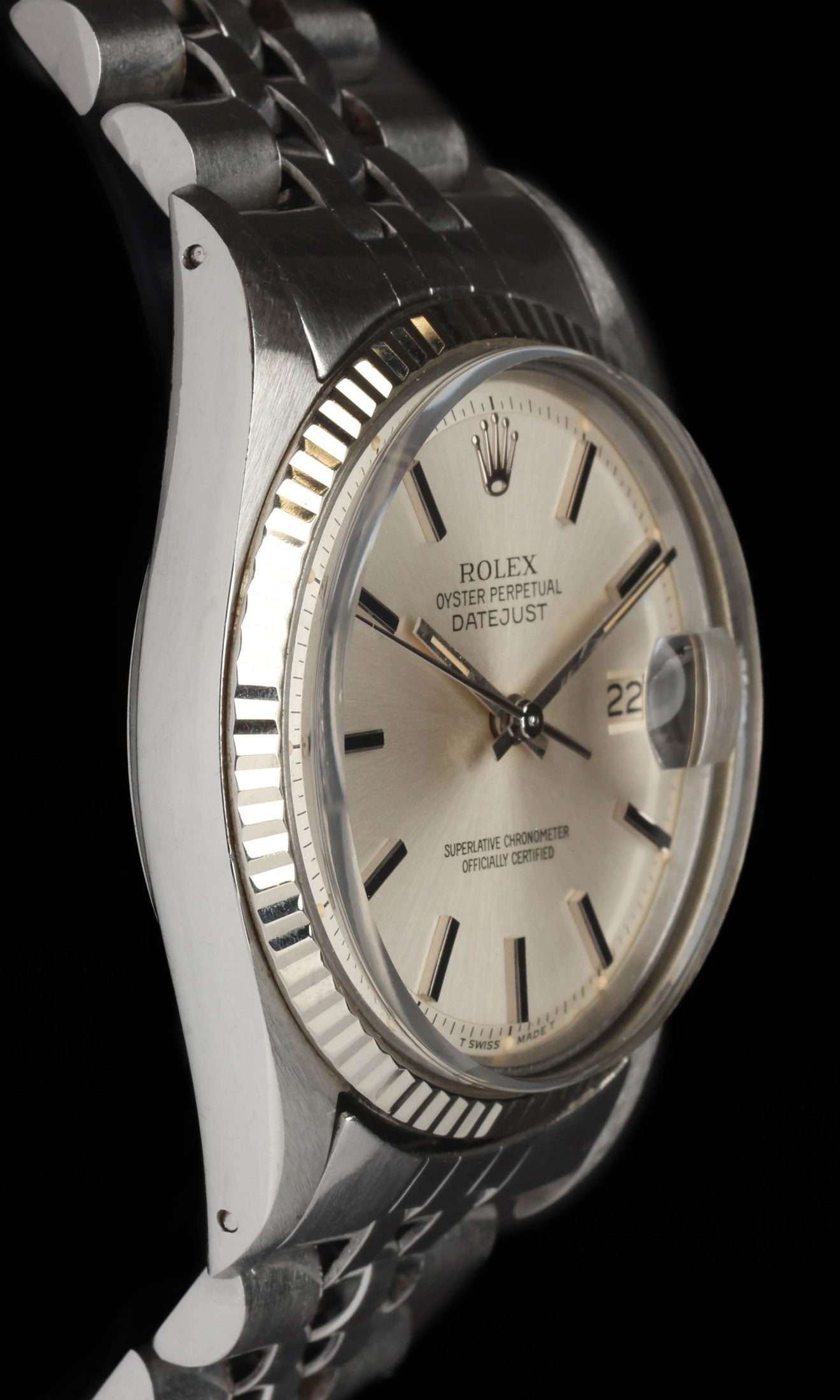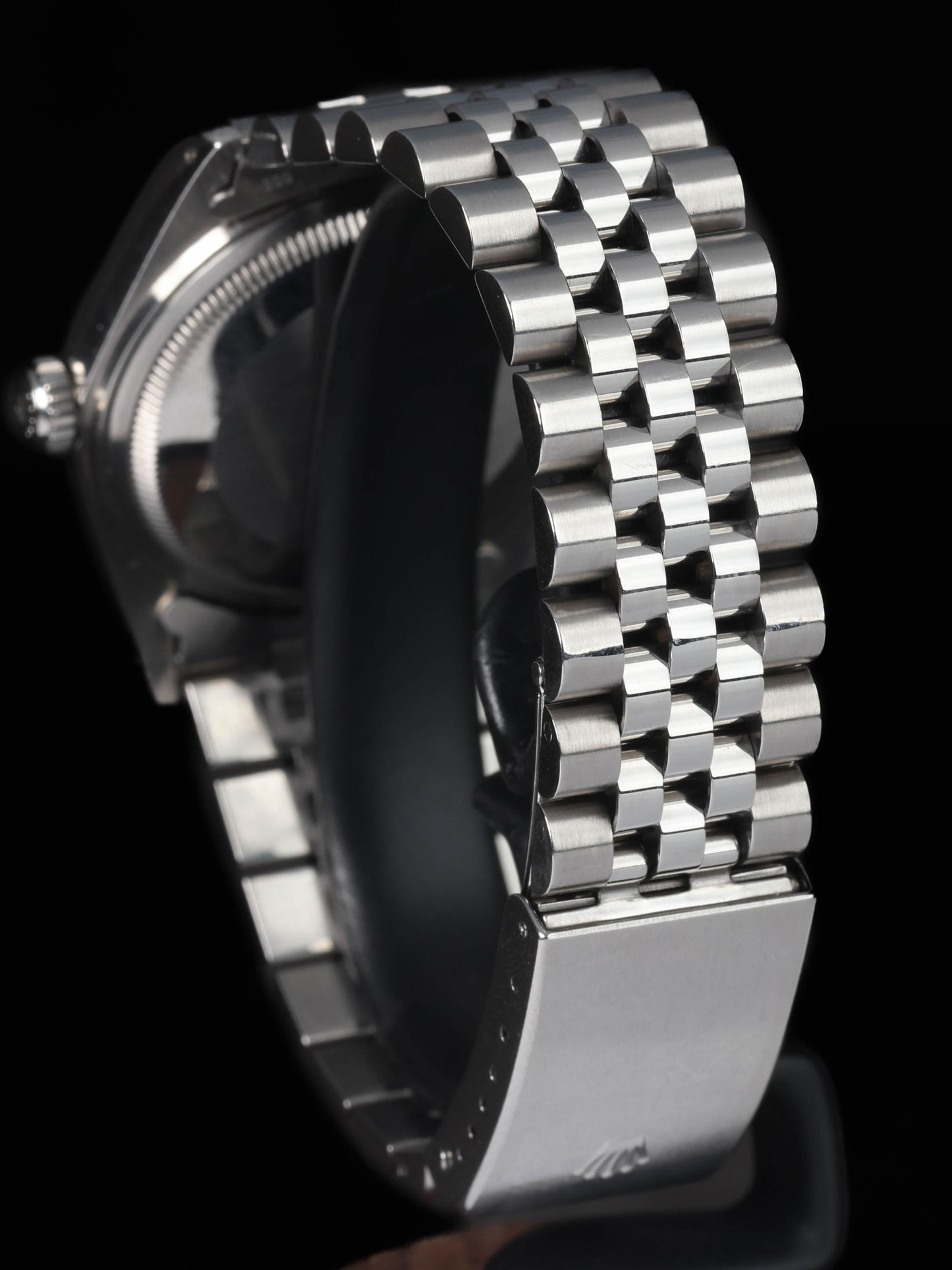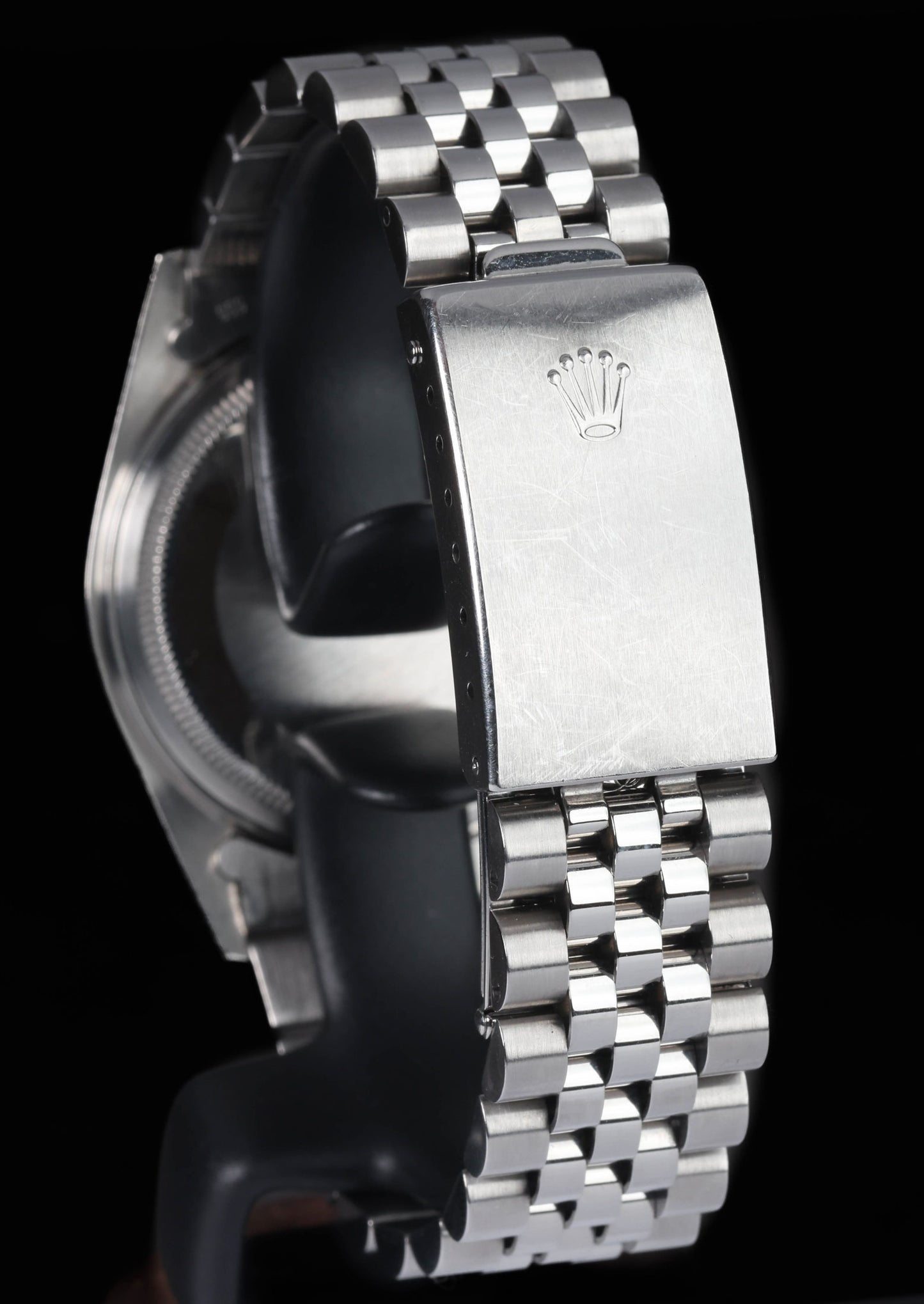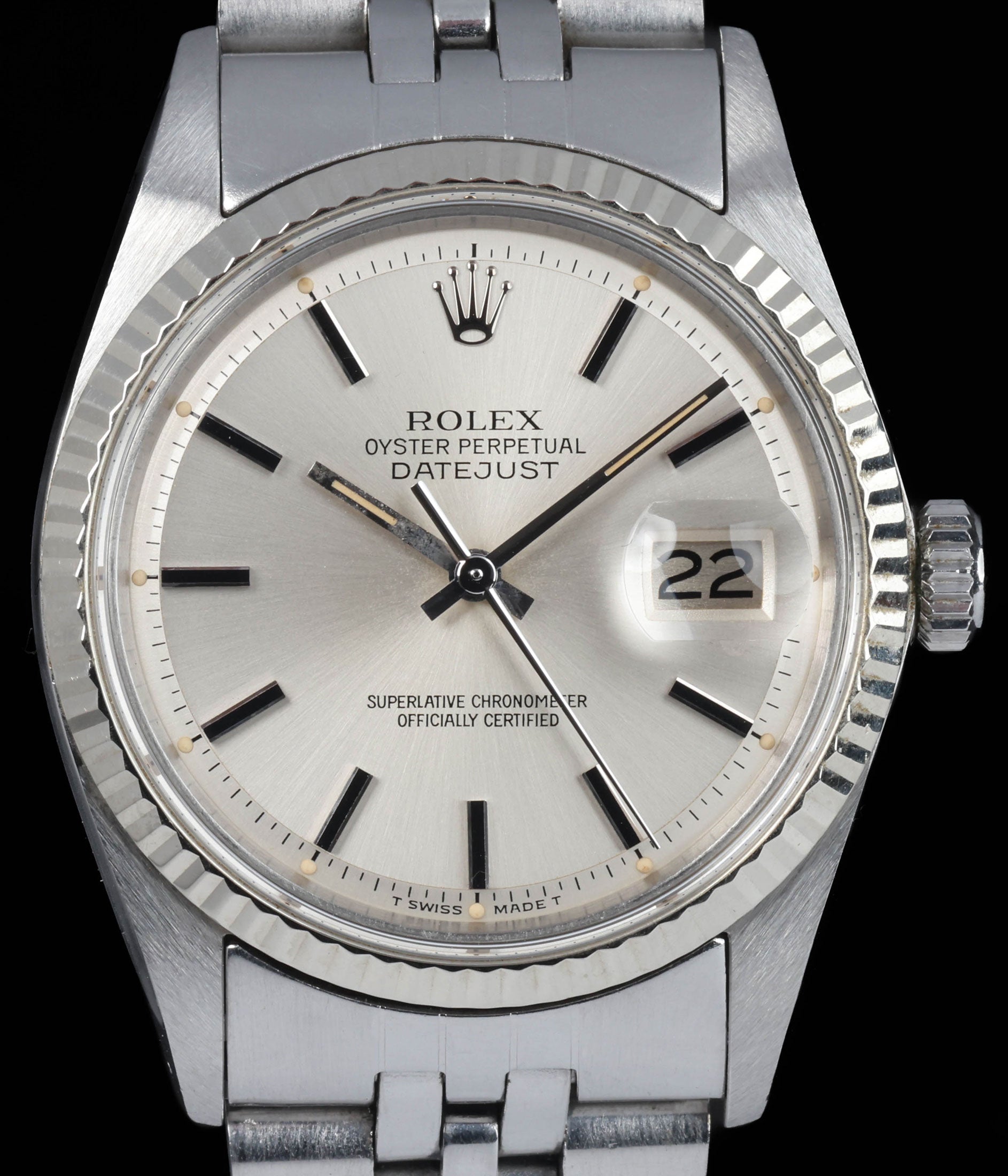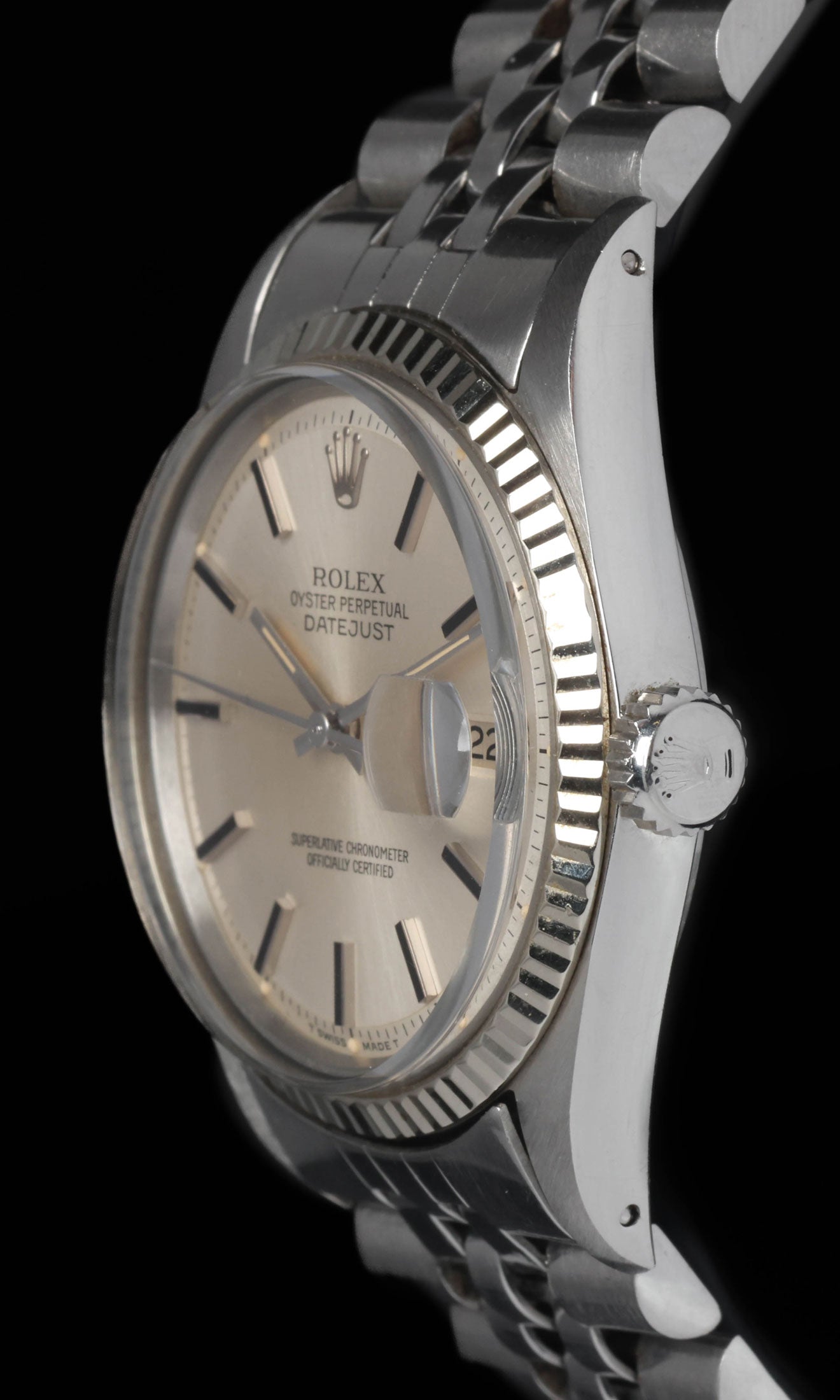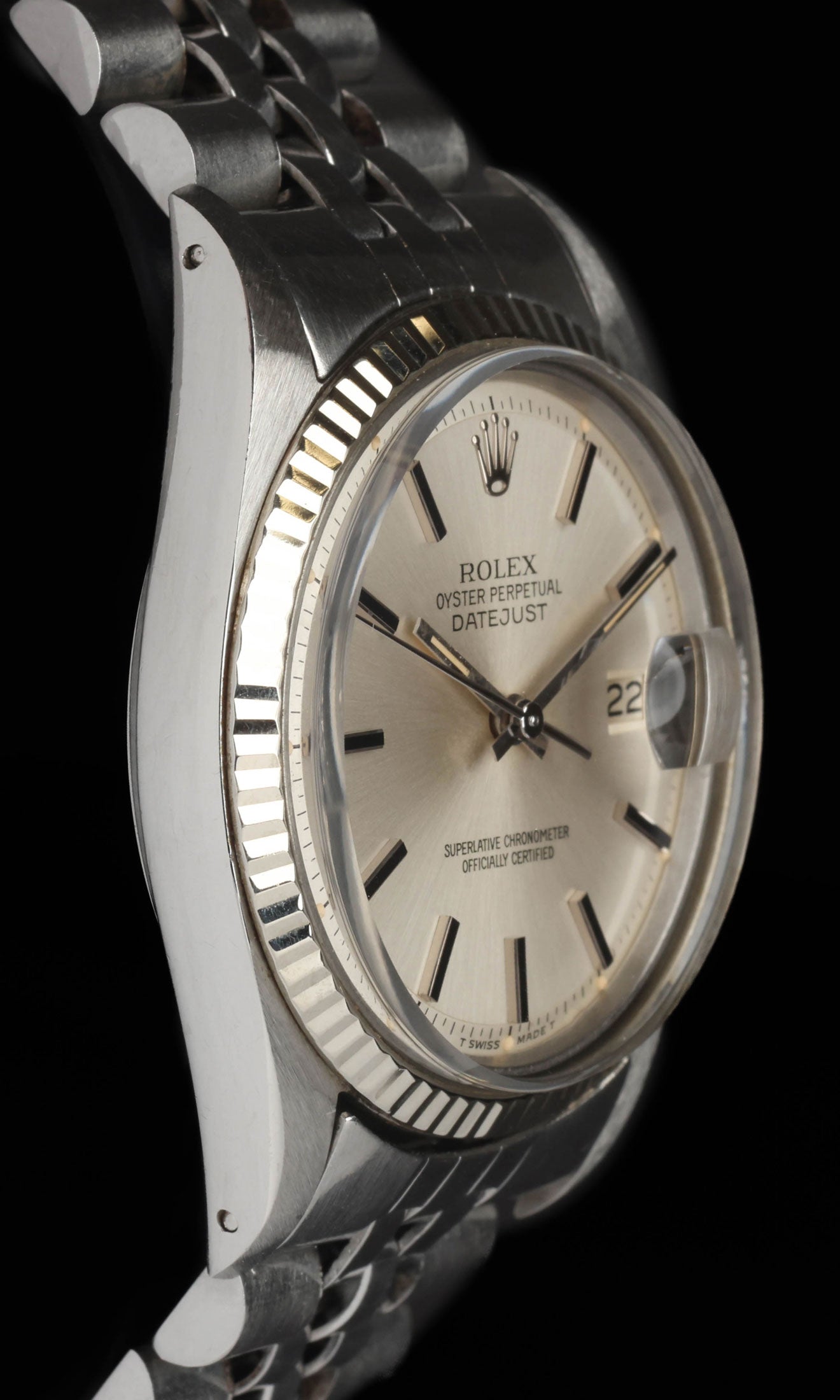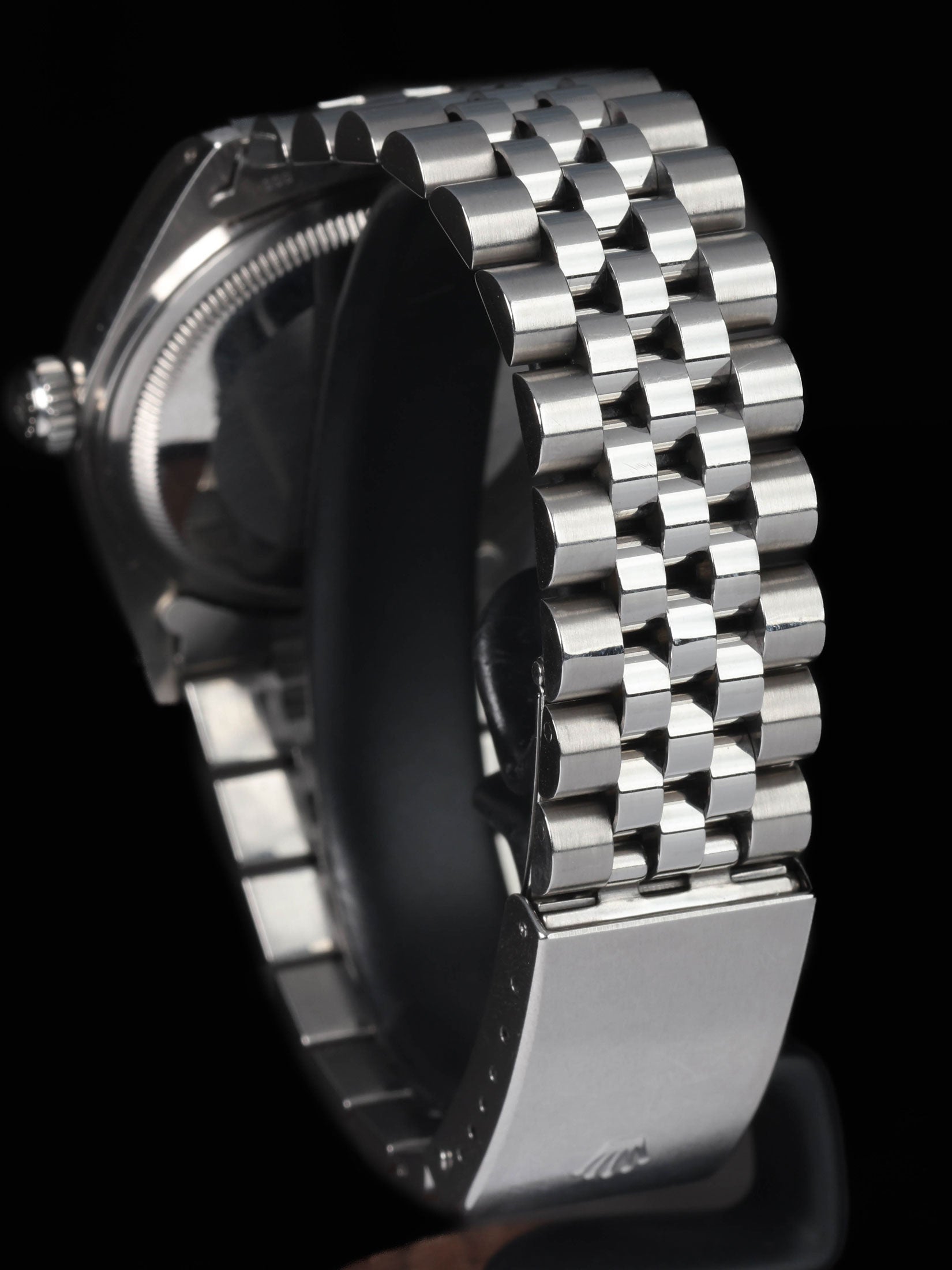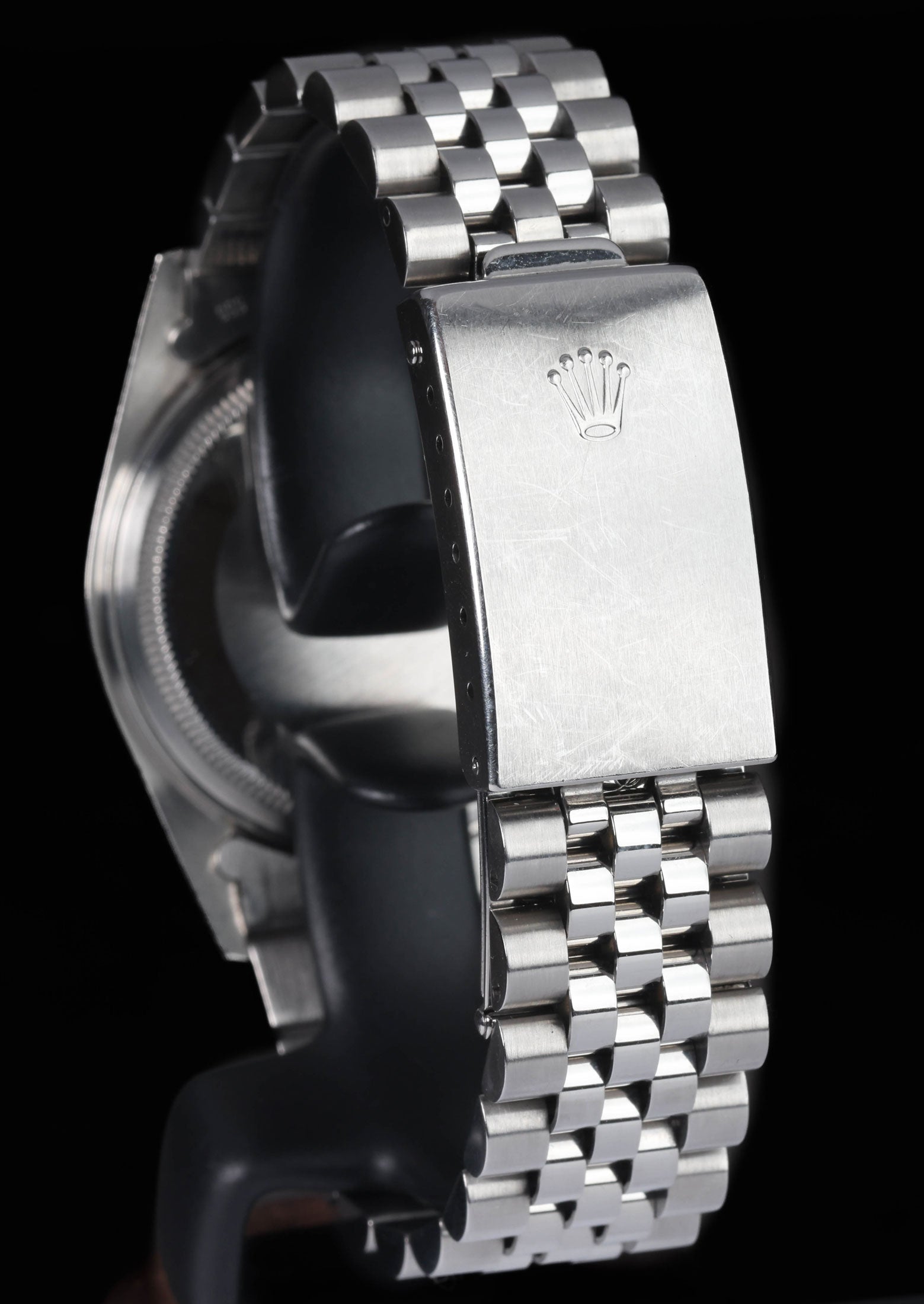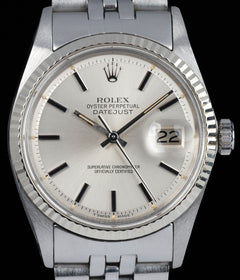Crown Vintage
Rolex Datejust 1601 36MM 'Pie Pan' 1978
Rolex Datejust 1601 36MM 'Pie Pan' 1978
Couldn't load pickup availability
Rolex Datejust 1601 36MM 'Pie Pan' 1978
This stunning Rolex Datejust 1601 from 1978 featuring the iconic pie pan dial boasts a character and charm that only decades of careful wear can deliver. The dial and hands are truly flawless, with both showcasing a beautifully uniform patina that adds depth and warmth to this already iconic design. The applied indices and lume plots maintain their crisp details, perfectly complementing the softly aged tones. This is a dial that tells a story while retaining the impeccable balance and legibility for which Rolex is celebrated.
The stainless steel case, measuring a classic 36mm, is in excellent condition, with sharp lugs and no visible flaws. It retains its original profile, ensuring its proportions are as Rolex intended. The bracelet exhibits minimal stretch,which is excellent for its age.
Share
Why we love this watch
Why we love this watch
The Rolex Datejust 1601 Pie-Pan: An Icon of Elegance
Introduction
The Rolex Datejust has long been considered the quintessential luxury wristwatch, combining timeless design with technical innovation. Among the most enduring references is the Datejust 1601, produced during the mid-20th century and into the 1970s. Distinguished by its fluted bezel and pie-pan dial, the 1601 captures a defining moment in Rolex history, when the Datejust had matured into the brand’s flagship dress watch. An example from 1970 showcases everything that makes this reference special: a balanced design, versatile functionality, and the refinement of Rolex’s Oyster case paired with a Jubilee bracelet.
The pie-pan dial configuration—so named for the sloping edge around its perimeter—adds depth and character to the watch, setting it apart from later Datejusts with flat dials. Combined with the fluted bezel in white gold, the Datejust 1601 pie-pan remains one of the most emblematic Rolex watches of its time.
Origins of the Rolex Datejust
The Datejust was introduced in 1945 to mark the 40th anniversary of Rolex. It was the first automatic wristwatch to feature an automatically changing date complication, an innovation that set a new benchmark in watchmaking. The original Datejust, reference 4467, came in a gold case with a coin-edge bezel and was paired with the debut of the Jubilee bracelet, a five-link design created specifically for this model.
Over the next two decades, the Datejust evolved with refinements to the case, movement, and dial design. By the late 1950s, Rolex had standardised many of the traits that we now associate with the Datejust: the Oyster case, Cyclops lens over the date, fluted bezel, and the Jubilee bracelet. The reference 1601, introduced around 1959, epitomised this formula and remained in production for nearly two decades.
The Reference 1601
The Datejust 1601 was offered in stainless steel with a white gold bezel, in full yellow gold, and in two-tone steel and yellow gold configurations. This flexibility ensured the model appealed to a wide audience, from those seeking understated elegance to those desiring a more overt display of luxury.
At 36mm in diameter, the Oyster case of the 1601 struck the perfect balance between presence and wearability. The screw-down crown and caseback ensured water resistance, while the acrylic crystal, with its Cyclops magnifier, provided clear legibility of the date display at 3 o’clock.
The defining feature of the 1601, however, was its pie-pan dial. The sloping outer edge gave the dial a sense of depth and dimension, creating a subtle play of light across its surface. Offered in a variety of colours—including silver, champagne, black, and even more unusual tones—the pie-pan dial is now considered one of the most charming details of vintage Datejusts.
The Pie-Pan Dial
The pie-pan dial became one of the defining design elements of mid-century Rolex watches, not just in the Datejust but also in Day-Date models. The sloping chapter ring around the dial provided visual separation for the minute track and hour markers, creating a sense of balance and proportion.
For the Datejust 1601, hour markers were typically applied baton indices in white gold or yellow gold, depending on the case configuration. Many examples also featured luminous plots of tritium at the ends of the indices, paired with luminous inserts in the hands. Over time, these tritium applications often develop a warm patina, adding to the vintage appeal of the watch.
The hands followed Rolex’s established design language for the Datejust, with slender stick hands for the hours and minutes and a simple seconds hand sweeping across the dial. The Cyclops magnifier above the date window, introduced in the 1950s, became a signature of the model and remains so today.
The Fluted Bezel
One of the most recognisable features of the Datejust 1601 is its fluted bezel. While the bezel design has practical origins—originally intended to screw onto the case for water resistance—the fluted bezel became a decorative element in its own right. In the 1601, the bezel was executed in white or yellow gold, even when the case itself was stainless steel.
This detail gave the watch a subtle touch of luxury while also providing contrast against the steel case. The sharp, reflective surfaces of the fluting catch the light beautifully, making the bezel one of the most visually striking elements of the watch.
Movement: Calibre 1570
Inside the 1601 was Rolex’s calibre 1570, one of the most robust and reliable automatic movements of its era. An evolution of the calibre 1530, the 1570 featured a free-sprung balance with Microstella regulation, a Breguet overcoil hairspring, and a bi-directional winding rotor. It operated at a frequency of 19,800 vibrations per hour, providing excellent accuracy and durability.
The calibre 1570 was chronometer-certified, as indicated by the text “Superlative Chronometer Officially Certified” on the dial. Its construction was deliberately over-engineered to ensure longevity, and many examples remain in excellent working order decades later.
One feature the calibre 1570 lacked was the quickset date, which would only be introduced in the 1970s with the calibre 3035. As a result, setting the date on a 1601 requires advancing the hands through 24-hour cycles—a process familiar to those who wear vintage Rolex watches.
The Jubilee Bracelet
The Datejust 1601 was most often paired with the Jubilee bracelet, which had been created specifically for the Datejust in 1945. Its five-link construction provided a more refined and dressy appearance compared to the three-link Oyster bracelet.
On vintage 1601 models, the Jubilee bracelet is often found with hollow centre links and a stamped clasp, making it light and flexible on the wrist. While some examples were fitted with Oyster bracelets, the Jubilee remains the quintessential pairing for the Datejust, enhancing its elegance and comfort.
The Datejust in Context
By 1970, the Rolex Datejust had become firmly established as a symbol of success and refinement. It was not tied to any single profession or sport, unlike Rolex’s tool watches such as the Submariner or GMT-Master. Instead, the Datejust was positioned as the watch for all occasions—a versatile piece that could be worn in business settings, at formal events, or casually.
The 1601 reflected the values of its time: understated elegance, technical precision, and enduring style. While the world of watchmaking was about to undergo dramatic changes with the advent of quartz technology, the mechanical Datejust continued to represent the pinnacle of reliable luxury.
Historical Significance of the 1601
The reference 1601 is historically significant for several reasons. First, it represents the mature design of the classic Datejust, with all the elements that have come to define the model: pie-pan dial, fluted bezel, Jubilee bracelet, and Cyclops lens. Second, it was powered by the calibre 1570, a movement that exemplified Rolex’s reputation for reliability and accuracy.
Finally, the 1601 was produced in large numbers over many years, making it one of the most accessible vintage Rolex references today. Yet within its wide production run, subtle variations in dial colour, markers, and lume create an endless variety of detail for those who study the model.
The Appeal of the Pie-Pan Dial Today
The pie-pan dial of the 1601 has become especially desirable in recent years. Later Datejust references moved to flat dials, losing the stepped edge that gives earlier models their unique character. The pie-pan dial not only adds visual depth but also reflects the craftsmanship of Rolex in an era before production was fully industrialised.
When combined with the warm patina that develops on vintage tritium lume and the play of light on the fluted bezel, the pie-pan dial 1601 offers a richness that modern watches often cannot replicate. It is a reminder of a time when even Rolex’s most versatile model carried subtle details that elevated its design.
A Watch of Its Time
The Datejust 1601 pie-pan embodies the design ethos of the late 1960s and early 1970s. Its 36mm case was considered perfectly proportioned, its pie-pan dial reflected mid-century aesthetics, and its Jubilee bracelet spoke to an age of elegance. While many watches from the period now feel dated, the 1601 continues to look contemporary, a testament to Rolex’s mastery of timeless design.
The enduring appeal of the 1601 lies in this combination of vintage charm and modern usability. It is a watch that can be worn daily while still offering the character of a bygone era.
Final Thoughts
The Rolex Datejust 1601 pie-pan stands as one of the most iconic dress watches ever made. With its 36mm Oyster case, white gold fluted bezel, Jubilee bracelet, and pie-pan dial, it captures the essence of Rolex’s mid-century design language. Powered by the calibre 1570, it offered unmatched reliability and accuracy, while its aesthetic details elevated it beyond a mere timekeeper into a symbol of refinement.
Case & Bracelet
Case & Bracelet
- Case & bracelet in very good condition, light hairlines visible. No major wear, dents or pitting.
- Bracelet in good vintage condition, end links aftermarket.
Dial & Hands
Dial & Hands
- Dial & hands very good
- Both forming nice patina
Warranty & Condition
Warranty & Condition
Crown Vintage Watches provides a minimum 3-month mechanical warranty on pre-owned watches, from the date of purchase.
The warranty covers mechanical defects only.
The warranty does not cover damages such as scratches, finish, crystals, glass, straps (leather, fabric or rubber damage due to wear and tear), damage resulting from wear under conditions exceeding the watch manufacturer’s water resistance limitations, and damage due to physical and or accidental abuse.
Please note, water resistance is neither tested nor guaranteed.
Shipping and insurance costs for warranty returns to us must be covered by the customer. Returns must be shipped via traceable courier. Return shipment must be pre-paid and fully insured. Collect shipping will be refused. In case of loss or damages, the customer is liable.
Our Pledge
At Crown Vintage Watches, we stand by the authenticity of every product we sell. For added peace of mind, customers are welcome to have items independently authenticated at their own expense.
Condition
Due to the nature of vintage timepieces, all watches are sold as is. We will accurately describe the current condition and working order of all watches we sell to the best of our ability.
Shipping & Refund
Shipping & Refund
